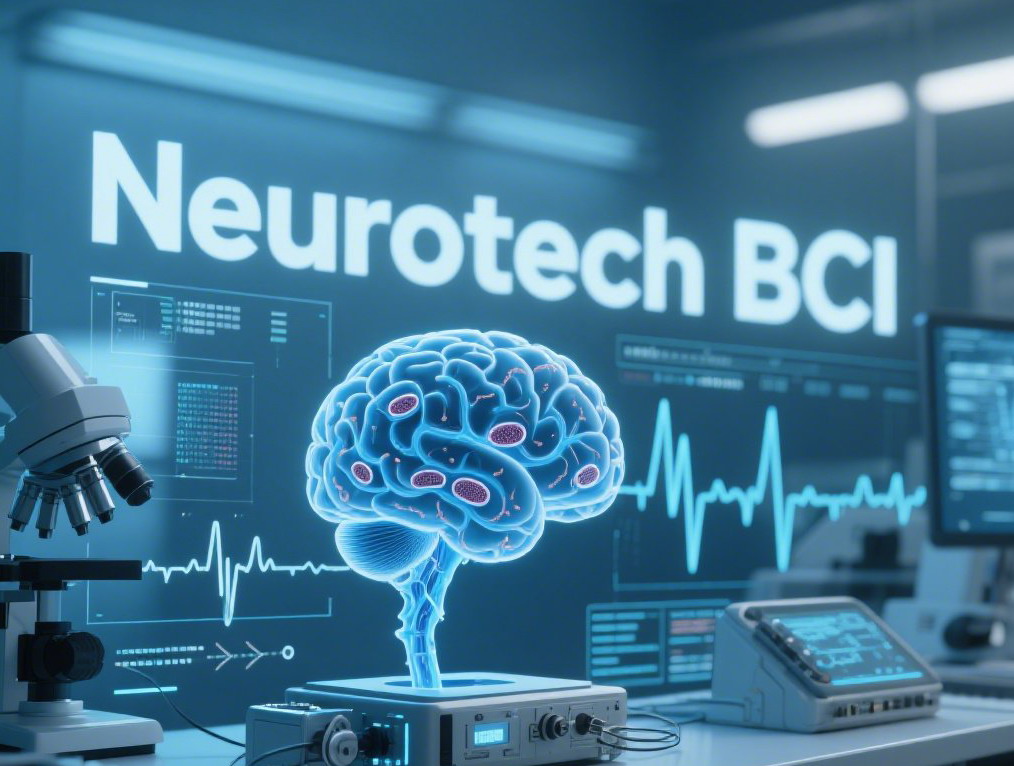
Neurotech BCI (Brain-Computer Interface) represents the cutting-edge fusion of neuroscience and engineering, enabling direct interaction between the brain and external devices through thought-driven control. Its core objectives include restoring neurological function, enhancing cognitive capabilities, and revolutionizing human-machine collaboration. Below is a detailed breakdown of its technical framework, applications, and future trends:
I. Technical Definition and Core Components
1. Definitions
- Neurotech: Technologies that study, modulate, or enhance the nervous system, including BCIs, neural prosthetics, and neuromodulation.
- BCI: Sensors capture brain signals (e.g., EEG, ECoG, LFP), decode user intent, and translate it into commands for external devices (e.g., robotic arms, computer interfaces).
2. Technical Architecture
- Signal Acquisition:
- Invasive: Implanted electrodes (e.g., Neuralink’s N1 chip) directly record neural activity (high precision but requiring surgery).
- Non-invasive: Scalp EEG, fNIRS, or other methods (safer but noise-prone).
- Signal Processing:
- Feature Extraction: Machine learning (e.g., deep learning) isolates patterns like motor intent or speech imagery.
- Real-Time Decoding: Algorithms (e.g., Kalman filters, SVM) convert neural signals into actionable commands.
- Feedback & Execution:
- Neuromodulation: Electrical or optogenetic stimulation to regulate brain activity (e.g., DBS for Parkinson’s disease).
- Device Control: Exoskeletons, wheelchairs, or virtual keyboards enable “mind-typing” or mobility restoration.
II. Applications and Breakthroughs
1. Medical Rehabilitation
- Motor Function Restoration:
- Paralyzed patients control robotic arms via BCI (e.g., Blackrock Neurotech trials).
- Spinal cord injury patients regain walking ability with brain-controlled exoskeletons (e.g., Onward Medical’s ARC-IM).
- Neurological Disorders:
- Epilepsy: Closed-loop BCI systems detect and suppress seizures in real time.
- Depression: Deep Brain Stimulation (DBS) modulates prefrontal cortex activity for treatment-resistant cases.
2. Cognitive Enhancement & Human-Machine Collaboration
- Memory & Attention:
- Transcranial Direct Current Stimulation (tDCS) enhances working memory in high-intensity professionals.
- Brain-Controlled Systems:
- Gamers use EEG headsets for “mind-controlled” avatars (e.g., OpenBCI’s Galea).
- Military applications deploy brain-controlled drone swarms for rapid battlefield response.
3. Emerging Synergies
- AI Integration:
- Large language models (e.g., GPT-5) combined with BCI enable thought-driven natural language generation (e.g., ALS communication aids).
- Metaverse Interface:
- Non-invasive BCI captures user emotions and attention data to personalize VR/AR content.
III. Market Landscape and Competition
1. Industry Ecosystem
- Upstream:
- Hardware: High-density electrode arrays (e.g., Neuralink’s “sewing robot”), flexible electronics (e.g., NeuroPixels probes).
- Software: Open-source decoding frameworks (e.g., BCI2000, OpenVibe) and cloud-based signal processing.
- Downstream:
- Healthcare: Neural prosthetics (e.g., Synchron’s Stentrode), cognitive intervention devices.
- Consumer Tech: EEG headsets (e.g., Emotiv Epoc X), brain-controlled smart home systems.
2. Regional Dynamics
- North America:
- Neuralink and Blackrock Neurotech lead invasive BCI trials, accelerated by FDA’s Breakthrough Device Program.
- Asia-Pacific:
- China’s “Brain Initiative” focuses on non-invasive BCI for stroke recovery and ADHD treatment (e.g., Borui Kang’s EEG devices).
- Japan’s DNA Chip Research Institute develops BCI-driven anti-fatigue industrial safety systems.
3. Investment Trends:
- Global BCI funding exceeds $2B (2024-2025), targeting:
- Invasive Closed-Loop Systems: Motif Neurotech’s millimeter-scale wireless implants.
- Neuromodulation Therapies: INBRAIN Neuroelectronics’ graphene electrodes for Parkinson’s disease.
IV. Challenges and Ethical Debates
1. Technical Hurdles
- Signal Fidelity: Non-invasive EEG struggles with noise; invasive implants risk glial scarring.
- Generalization: Cross-user decoding models lag due to individual neural variability.
2. Engineering Obstacles
- Miniaturization & Power: Implants require high channel counts (>1,000) with wireless energy solutions (e.g., ultrasonic/RF).
- Latency: Motion control delays must stay under 200ms for seamless user experience.
3. Ethics & Regulation
- Privacy Risks: Brain signals may leak subconscious intent or emotional states.
- Cognitive Autonomy: Philosophical debates on whether neural enhancement alters “human essence.”
- Regulatory Fragmentation: Lack of global standards for BCI data security and clinical approval.
V. Future Outlook (Next Decade)
1. Technological Convergence
- Bio-Electronic Interfaces:
- Self-healing electrodes (e.g., hydrogels) minimize implant damage; biomimetic synapses improve signal efficiency.
- Quantum Neurotech:
- Quantum sensors (e.g., NV centers) enable nanoscale resolution of single-neuron magnetic fields.
2. Expanded Applications
- Holistic Health Monitoring:
- Wearable BCI tracks stress/sleep quality, integrated with AI for personalized interventions.
- Cross-Species Communication:
- Animal BCI decodes ecological behavior for conservation and disaster预警.
3. Societal Impact
- Workforce Transformation: Brain-controlled robots may replace high-risk jobs (e.g., deep-sea welding).
- Education Revolution: BCI-driven “neuroplasticity training” accelerates skill acquisition (e.g., languages, music).
Conclusion
Neurotech BCI stands at the frontier of neuroscience and engineering, reshaping human interaction with physical and digital worlds. While medical and military applications are already emerging, cognitive enhancement and metaverse integration remain nascent. Despite technical and ethical challenges, advancements in materials science, AI, and policy frameworks will position BCI as a cornerstone of societal transformation by the 2030s. For investors and innovators, focusing on invasive closed-loop systems, neuromodulation therapies, and interdisciplinary convergence will be key to navigating this transformative wave.

“Neurotech BCI” 是神经科技(Neurotechnology)与脑机接口(Brain-Computer Interface, BCI)的融合技术,其核心定义与应用如下:
1. 技术定义
Neurotech(神经科技):通过工程手段干预或增强神经系统功能的跨学科领域,涵盖脑科学、生物电子学等。
BCI(脑机接口):直接建立大脑与外部设备的通信链路,实现脑电信号与计算机指令的双向交互。
组合后指基于神经科技的脑机接口系统,强调通过先进技术解码或调控神经活动。
2. 核心功能
医疗康复:帮助瘫痪患者通过意念控制机械臂完成进食等动作,或治疗中风、ALS等神经系统疾病。
神经调控:通过电刺激或信号反馈修复认知或运动功能障碍。
功能增强:探索意念控制智能设备(如虚拟界面)或认知能力提升。
3. 技术挑战
信号稳定性:植入式设备易受生物组织反应影响,长期可靠性待突破。
用户适配:需个性化训练以适配脑电信号差异,过程复杂耗时。